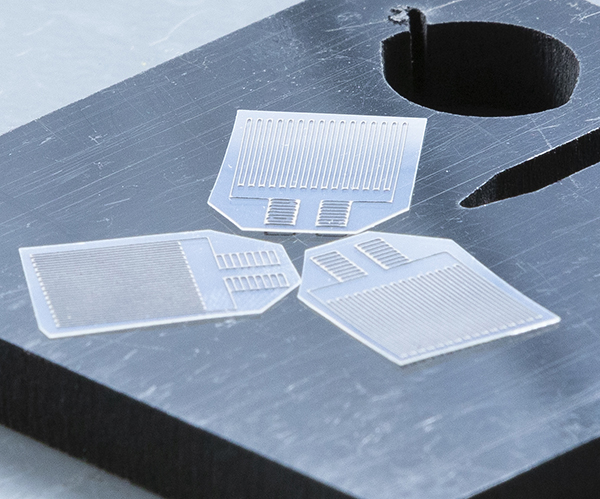
Professor Subramanian Ramakrishnan led a team that created these silver ink-based strain sensors for NASA that outperform conventional sensors for space applications. The work is part of a grant to create new technology for the agency while building a more balanced engineering workforce. (Scott Holstein/FAMU-FSU Engineering)
Subramanian Ramakrishnan, a FAMU-FSU College of Engineering professor in the Department of Chemical & Biomedical Engineering, was recently awarded a $300,000 grant from NASA to inspire students to participate in research for the science agency and to pursue STEM degrees.
They will get valuable training and help build next-generation sensors needed for NASA’s space program.
“This is an area of national need, solving problems in space exploration and discovery and to train the next generation workforce,” Ramakrishnan said. “Building a multicultural engineering profession is very important to the joint college and NASA.”
Ramakrishnan and his multidisciplinary research team use additive technology manufacturing to provide on-demand and affordable solutions to produce silver ink-based strain sensors for NASA. Beth Paquette, an aerospace engineer at NASA’s Goddard Space Flight Center in Greenbelt, Maryland; and Curtis Hill, and a principal investigator and researcher at NASA’s Marshall Space Flight Center in Huntsville, Alabama; are collaborating on the project.
Using a 3-D printing process coupled with a laser annealing method, the team has designed sensors that perform better than conventional strain sensors. The new technique results in devices with high gauge factors, which increases the output signal.

“The sensors use the advanced technology of our new nScrypt machine, which allows us to print on curved surfaces,” Ramakrishnan said. “We are also experimenting with novel ink formations and process parameters that will result in new design rules and better methods for fast additive manufacturing of next-generation sensors at NASA.”
The grant project, “Additive Manufacturing of Electronics for NASA Applications,” involves collaborators from the college along with NASA Goddard and NASA Marshall. The two-year grant, through NASA’s Science Mission Directorate (SMD) Bridge Program, is designed to boost multicultural, equivalence, all-embracing and accessibility within the NASA workforce and the U.S. science and engineering community.
NASA BRIDGING THE GAP
The money was awarded to the joint college through Florida A&M University (FAMU). The team is one of 11 institutions that were not historically part of the agency’s research enterprise and represent new collaborations for NASA. The projects offer hands-on training and mentorship for students.
The program builds a sustainable partnership with NASA, increasing FAMU’s research capability while creating multiple research opportunities for undergraduate and graduate students in space-relevant STEM fields. A strong emphasis on mentorship is part of the overall program.
“The SMD Bridge Program aims to expand access to NASA research opportunities to students and faculty at a broad array of under-resourced institutions, to transition students into graduate school or STEM careers and increase long-term partnerships between faculty and NASA researchers,” said SMD Bridge program director Padi Boyd at NASA Headquarters in Washington.
“This first cohort of Bridge Program Seed Funding teams bring faculty, students and NASA researchers together to study important processes at work on Earth and in its atmosphere, such as environmental pollution and wildfire science,” Boyd said. “Some projects inform the search for life beyond Earth, while others push the boundaries of future detectors, instruments and flight missions. I’m excited to see where this research takes the students and NASA in the future.”
STUDENT SUCCESS
“Students will spend fall and spring semesters at the college and work with NASA scientists at one of the centers,” Ramakrishnan said. “They will have access throughout the year for mentorship opportunities and networking. The students will be learning while making a product to launch future rocket missions.”
The team, their collaborators and NASA scientists plan to tackle numerous problems with the project. The success of the research will impact and improve the success of endeavors, including patents and startups. The proposal may play a role in the newly formed materials science and engineering department at the FAMU-FSU College of Engineering.
“Student success is our primary goal,” Ramakrishnan said. “We want to motivate students to pursue careers in STEM and understand what NASA has to offer. They can network, publish good journal articles and conduct research. Hopefully, this will motivate undergraduates to graduate school and get their doctorates and encourage them to get jobs in the industry.”
RELATED ARTICLES
Engineering professor Subramanian Ramakrishnan receives prestigious 3M Professorship at FAMU
